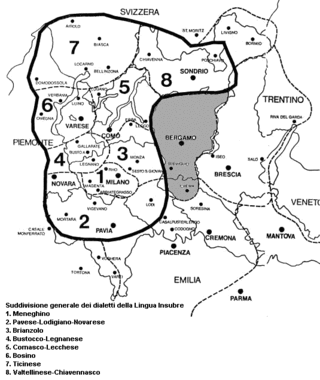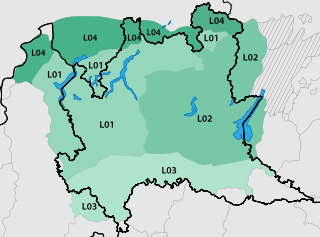
Piedmontese is a language spoken by some 2,000,000 people mostly in Piedmont, a region of Northwest Italy. Although considered by most linguists a separate language, in Italy it is often mistakenly regarded as an Italian dialect. It is linguistically included in the Gallo-Italic languages group of Northern Italy, which would make it part of the wider western group of Romance languages, which also includes French, Occitan, and Catalan. It is spoken in the core of Piedmont, in northwestern Liguria, and in Lombardy.

The Lombard language belongs to the Gallo-Italic family and is a cluster of homogeneous dialects that are spoken by millions of speakers in Northern Italy and southern Switzerland, including most of Lombardy and some areas of the neighbouring regions, notably the eastern side of Piedmont and the western side of Trentino, and in Switzerland in the cantons of Ticino and Graubünden. The language is also spoken in Santa Catarina in Brazil by Lombard immigrants from the Province of Bergamo, in Italy.
Milanese is the central variety of the Western dialect of the Lombard language spoken in Milan, the rest of its metropolitan city, and the northernmost part of the province of Pavia. Milanese, due to the importance of Milan, the largest city in Lombardy, is considered one of the most prestigious Lombard variants and the most prestigious one in the Western Lombard area.
The Ticinese dialect is the set of dialects, belonging to the Alpine and Western branch of the Lombard language, spoken in the northern part of the Canton of Ticino (Sopraceneri); the dialects of the region can generally vary from valley to valley, often even between single localities, while retaining the mutual intelligibility that is typical of the Lombard linguistic continuum.

The Gallo-Italic, Gallo-Italian, Gallo-Cisalpine or simply Cisalpine languages constitute the majority of the Romance languages of northern Italy: Piedmontese, Lombard, Emilian, Ligurian, and Romagnol. In central Italy they are spoken in the northern Marches ; in southern Italy in some language islands in Basilicata and Sicily.
Western Lombard is a group of dialects of Lombard, a Romance language spoken in Italy. It is widespread in the Lombard provinces of Milan, Monza, Varese, Como, Lecco, Sondrio, a small part of Cremona, Lodi and Pavia, and the Piedmont provinces of Novara, Verbano-Cusio-Ossola, the eastern part of the Province of Alessandria (Tortona), a small part of Vercelli (Valsesia), and Switzerland. After the name of the region involved, land of the former Duchy of Milan, this language is often referred to as Insubric or Milanese, or, after Clemente Merlo, Cisabduano.

Italo-Western is, in some classifications, the largest branch of the Romance languages. It comprises two of the branches of Romance languages: Italo-Dalmatian and Western Romance. It excludes the Sardinian language and Eastern Romance.

The Bergamasque dialect is the western variant of the Eastern Lombard group of the Lombard language. It is mainly spoken in the province of Bergamo and in the area around Crema, in central Lombardy.
Canzés is a variety of Brianzöö spoken in the commune of Canzo, Italy.
Eastern Lombard is a group of closely related variants of Lombard, a Gallo-Italic language spoken in Lombardy, mainly in the provinces of Bergamo, Brescia and Mantua, in the area around Cremona and in parts of Trentino. Its main variants are Bergamasque and Brescian.
Bustocco and Legnanese are two dialects of Western Lombard, spoken respectively in the cities of Busto Arsizio and Legnano, Lombardy.
The group of dialects Comasco-Lecchese is part of the Western Lombard language and is spoken in the province of Como and province of Lecco in Italy, especially around the capital cities and north of them. In other parts of this provinces, other Western Lombard varieties are spoken.
Vallassinese is variety of the Western Lombard language spoken in the Vallassina valley of Italy. It belongs to the Comasco-Lecchese group and it has many subdialects.
Novarese, locally pronounced Nuares, is a dialect of the Western Lombard language spoken in the province of Novara (Piedmont).

Cremonese (Cremunés) is a dialect of the Western Lombard dialect group spoken in the city and province of Cremona in Lombardy, Italy, with the exception of Crema and the area of Soresina, where an Eastern Lombard dialect is spoken, and the area of Casalmaggiore, where a form of Emilian closely related to Parmigiano is spoken.
Southwestern Lombard is a group of dialects of Western Lombard language spoken in the provinces of Pavia, Lodi, Novara, Cremona, in the south of the historic Insubria, and comprises Pavese, Ludesan, Novarese, Cremunés and others.
Comasco or Comasque is a dialect belonging to the Western branch of Lombard language, spoken in the city and suburbs of Como.
Laghée is a dialect of Western Lombard language spoken in the north of province of Como (Lombardy), on the coast of the eponymous lake.
Pavese is a dialect of Western Lombard language spoken in province of Pavia (Lombardy). In Pavese, differently from most of Western Lombard dialects, the "z" is transformed into "s".
Shahpuri is a Punjabi dialect spoken in the Sargodha Division of Punjab, Pakistan. Grierson considered it to be representative of Lahnda, but later opinions have tended to see it as a dialect of Punjabi that is transitional to Saraiki. Its name is derived from former Shahpur District.





